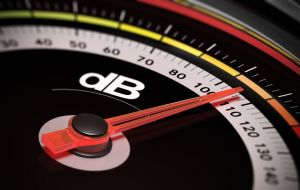[ad_1]
Contributed by Debbie Clason, staff writer, Healthy Hearing
Last updated
The soft whisper of a grandchild sharing a secret, the loud blare of a fire truck’s siren as it enters the intersection, the soothing melody of your favorite song on the radio. How do we measure the intensity of the sounds they make? Behold the humble decibel, a logarithmic way of describing a ratio between things like power, sound pressure and voltage.
Decibels measure sound intensity

represent a ratio.
Sound is energy that travels in waves and is measured in frequency and amplitude. Frequency, reported in Hertz (Hz), measures the number of sound vibrations in one second. Amplitude, reported on the decibel (dB) scale, measures its pressure or forcefulness. The more amplitude a sound has, the louder it is.
The logarithmic decibel scale measures differently than a linear scale. For example, every increase of 10 dB on the decibel scale is equal to a 10-fold increase in sound pressure level (SPL). Near silence is expressed as 0 dB but a sound measured at 10 dB is actually 10 times louder. If a sound is 20 dB, that’s 100 times louder than near silence.
Decibels and hearing loss
Decibels might be just another measuring stick if it weren’t for the damaging effects loud noise inflicts on our hearing. Whether it’s a one-time exposure to a loud explosion or daily exposure to an excessively noisy workplace or hobby, our hearing suffers the consequences. This type of hearing loss is known as noise-induced hearing loss (NIHL).
The National Institute on Deafness and Other Communication Disorders (NIDCD) says everyone is susceptible to hearing damage as a result of noise exposure. They estimate approximately 15 percent of Americans between the ages of 20 and 69 have hearing loss that may have been caused by exposure to loud noise at work or through leisure activities. Results from a 2010 survey conducted by the Centers for Disease Control and Prevention (CDC) reveal as many as 16 percent of teens (age 12-19) report some hearing loss that may have been caused by exposure to loud noise.
Scientists have studied the effects of NIHL and, based on the levels of sounds in our environment, established recommendations for safe listening. How loud is too loud? The louder the sound, the shorter the amount of time it takes to damage hearing. Repeated or prolonged (more than 8 hours a day) exposure to noise louder than 85 dB can permanently damage hearing. And, in case you’re wondering what types of sound measures 85 dB, here is a short list of common sounds and how they measure up:
- Normal conversation – 60 dB
- Heavy city traffic – 85 dB
- Lawn mower – 90 dB
- MP3 player at maximum volume – 105 dB
- Sirens – 120 dB
- Concerts – 120 dB
- Sporting events – 105 to 130 dB (depending upon the stadium)
- Firearms – 150 dB
Here’s some good news. Hearing health professionals say noise-induced hearing loss (NIHL) can be prevented if we pay attention to — and protect our ears from — the sounds around us. If you’re planning to attend a concert or sporting event or spend a lot of time woodworking, riding motorcycles or operating outdoor lawn equipment, you’ll be exposed to noise levels in excess of 85 dB. That’s when it’s a good idea to invest in some hearing protection.
- Ear plugs are inexpensive and can be found at most drug stores, but may not be suitable for extremely noisy situations. Foam ear plugs are disposable and conform to the shape of your ear; rubber or silicone ear plugs are washable and reusable.
- Custom ear molds may be desirable for musicians and other hobbyists. These can be ordered through a hearing healthcare professional.
- Earmuffs fit over the entire outer ear and muffle or block noise completely. Most are adjustable and can be found in sporting goods stores on online.
- Noise-cancelling headsets also muffle or block noise completely and are best for people who need to communicate (pilots, military personnel) while blocking outside noise.
If you’re unsure about what type of hearing protection is right for you, consult a hearing healthcare professional.
What do decibels mean to those with hearing loss?
Those who’ve already been diagnosed with hearing loss also need to be mindful of decibel levels in their environment. It’s all about protecting the hearing you have left.
- Untreated hearing loss: if you’ve been diagnosed with mild hearing loss, conserve the hearing you have left by wearing appropriate hearing protection. Untreated hearing loss in individuals who’ve had normal hearing can lead to a variety of other health conditions, such as an increased risk for dementia and depression as well as communication problems at work and home. Be proactive in conserving your remaining sense of hearing and resolve to seek treatment if your condition worsens.
- Hearing aid users: those who wear hearing aids should be mindful of dB levels in their environment, too. Hearing aids and other devices amplify sounds in the environment, so your remaining hearing is susceptible to noise-induced hearing loss just like everyone else’s. While it might be tempting to turn your devices off thinking that they will serve as protection, guess again. Most don’t fit snugly enough in the ear canal to block harmful sound and, when they are turned off, can prevent you from hearing desirable sounds — such as emergency vehicles, concert music, or the sporting announcer. Your best bet is to work with your hearing healthcare professional to identify the appropriate hearing protection for the type of activity you’ll be participating in or attending. Wearing the proper hearing protection will allow you to wear your hearing devices safely and still hear activity around you.
[ad_2]
Source link

